The Delta I
When Lippisch had received the order for a plane from Köhl, he originally designed a low
-wing version with a swept wing which was tested as a model. The flying characteristics were
unsatisfactory, so Lippisch decided to go to a swept leading edge and a straight
trailing edge wing. This would allow ample thickness of the mid wing even at large angles of sweep,
providing large volume for storage of loads. The name for this series of aircraft was Delta.
The Delta series used the previous method of development, starting with models, to full-scale gliders, and then powered aircraft. New methods of analysis were used in the wing design. In 1930, after flight tests of a large-scale model had proven satisfactory, construction began on the full size Delta.
The Delta I had a mid-position wing, with a strong main spar and plywood sheeted forward section of the wing, and fabric elsewhere. The rearward spar was for the attachment of the elevator and aileron flaps. The straight trailing edge allowed could be fitted with serarate elevator and aileron control survaces. The inner pair were elevators, and the outer pair ailerons. The ailerons could also be sued for trimming the elevators, and the elevators for adjusting lateral control.
The glider was completed in the summer of 1930, the Günther Groenhoff again performed the task of test flying during the Rhön Soaring Contest. The flying characteristics were satisfactory, but the plane bounced on landing, stressing the structure.
After a few flights, Köhl and Lippisch decided to equip the Delta with a small, pusher engine and a wheeled undercarriage instead of a skid. They went with a 30 hp Bristol -Cherub engine, and a three-wheel undercarriage (instead of two wheels and a tail skid).
This version of the Delta I was test flown on the Wasserkuppe by Groenhoff. Performance and control were excellent. Groenhoff flew the plane in many attitudes, even doing loops and aerobatics. It was decided to present the aircraft to the public at Berlin-Tempelhof airport. During the flight to Berlin, the engine developed trouble, and quit during landing. Examination showed that the main crankshaft bearing had overheated. The Director loaned them a second Bristol engine, and the aircraft demonstrated on September 25, 1931. Unfortunately, even through Groenhoff flew the aircraft through all sorts of aerobatics, financial support did not appear.
Captain Köhl started a test flight from Tempelhof which almost ended prematurely when the plane bounced during takeoff, snapping off the nosewheel. Köhl flew his flight without being aware of the damage to the aircraft, and was signaled by the ground crew that something was wrong. He made a successful landing without further damage.










